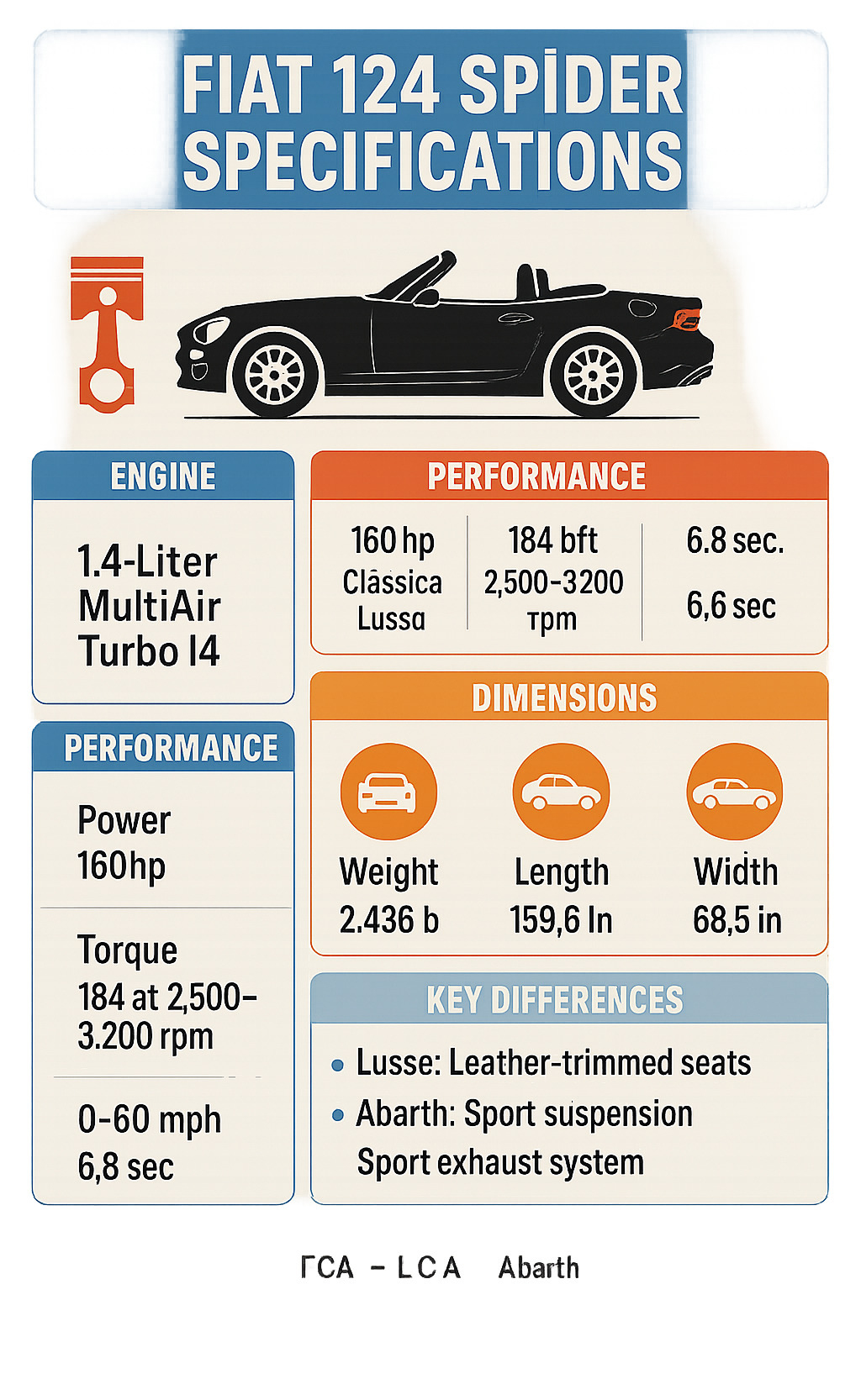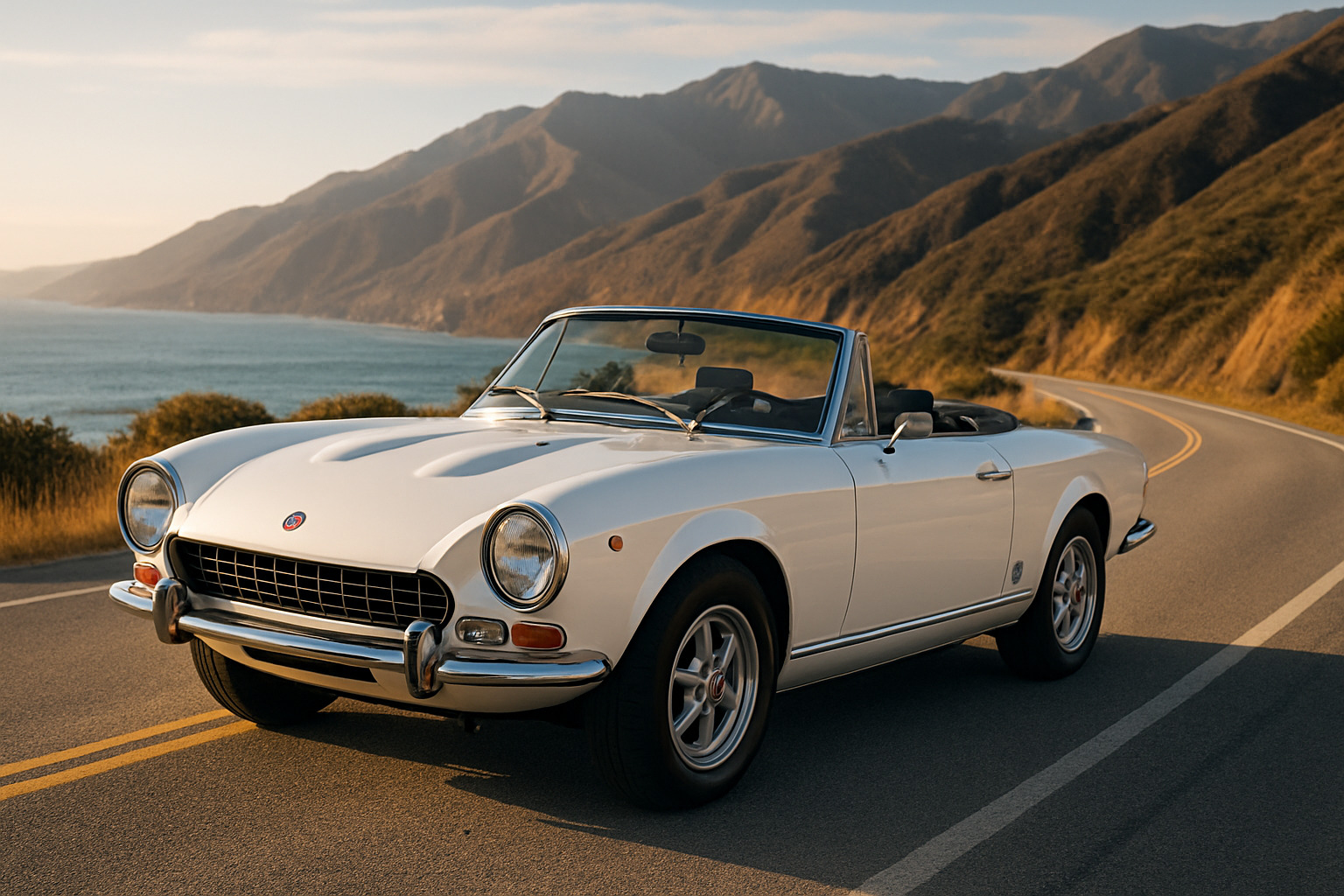fiat 124 spider specifications: 10 Powerful Facts for 2025
The Rebirth of an Italian Classic
When you see a Fiat 124 Spider gliding down a coastal highway, you’re witnessing automotive history reimagined. This isn’t just any roadster – it’s Italian passion with Japanese reliability, a combination that turns heads and warms hearts.
The Fiat 124 Spider specifications tell a compelling story of thoughtful engineering. At its heart beats a 1.4L MultiAir Turbo engine that delivers a spirited 160 horsepower in the Classica and Lusso trims, while the more mischievous Abarth squeezes out 164 hp. What really sets this roadster apart is its torque – a muscular 184 lb-ft that kicks in early between 2,500-3,200 rpm, giving you that satisfying push back in your seat when you hit the gas.
Weighing in at just 2,436-2,516 pounds (think of it as a heavyweight boxer in a lightweight division), the 124 Spider dances through corners with near-perfect 50:50 weight distribution. The center of gravity sits just 38.5 cm off the ground – practically hugging the asphalt as you carve through winding roads.
Transmission choices cater to both purists and daily commuters. The slick 6-speed manual offers the most engaging experience, sprinting from 0-60 mph in 6.8 seconds. If you prefer letting the car do the shifting, the 6-speed automatic adds about half a second to that time – a small price for convenience.
What’s particularly impressive is how the 124 Spider balances performance with practicality. The fuel economy numbers don’t read like a sports car at all – 26 mpg in the city and a highway-friendly 35 mpg with the manual transmission. That means more time enjoying the open road and less time at gas stations.
The double-wishbone front suspension paired with a multi-link rear setup delivers a ride that’s more refined than its Mazda cousin. As Jeremy Clarkson aptly noted, it’s “quieter and less fun” than the MX-5 – not because it’s boring, but because it leans more toward sophisticated grand touring than raw sportiness.
Everyday usability was clearly on the engineers’ minds. The manual soft top operates in just three seconds (no power mechanism needed), and the 4.9 cubic feet trunk leads its class in cargo space – room enough for a weekend getaway for two.
Produced from 2016 to 2020, the modern 124 Spider revived a nameplate with roots stretching back to 1966. While sharing its platform with the Mazda MX-5, Fiat gave it distinctly Italian styling cues and that turbocharged heart that beats to a different rhythm than the Miata’s naturally-aspirated engine.
| Specification | Details |
|---|---|
| Engine | 1.4L MultiAir Turbo I4 |
| Power | 160 hp (Classica/Lusso), 164 hp (Abarth) |
| Torque | 184 lb-ft @ 2,500-3,200 rpm |
| Transmission | 6-speed manual or 6-speed automatic |
| Weight | 2,436-2,516 lbs (1,050-1,080 kg) |
| 0-60 mph | 6.8 seconds (manual), 7.2 seconds (automatic) |
| Fuel Economy | 26/35 mpg (city/highway) with manual |
| Production Years | 2016-2020 |
Whether you choose the accessible Classica, the upscale Lusso, or the spirited Abarth, the 124 Spider delivers that rare combination – Italian flair you can actually rely on. It’s the roadster for those who appreciate la dolce vita but still need to make it to work on Monday morning.

Heritage & Trim Levels
The Fiat 124 Spider’s story begins with a splash of Italian drama. In 1966, the original model literally dropped into the automotive world when it was parachuted onto the floor of the Turin Auto Show. Designed by the legendary Pininfarina studio, this wasn’t just another car launch—it was theatrical automotive history in the making.
Half a century later in 2016, the 124 Spider nameplate made its triumphant return through a clever partnership between FCA (Fiat Chrysler Automobiles) and Mazda. This collaboration wasn’t just smart business—it was perhaps the only way to bring back a beloved roadster in an era of tightening regulations and rising development costs.
“In partnering with Mazda’s MX-5 Miata to resurrect the classic Fiat 124 Spider, Fiat Chrysler not only gained a halo sports car for its struggling Italian brand but likely saved the most celebrated small sports car of the past 25 years,” noted the Detroit News.
The reborn roadster represented a truly international affair—assembled at Mazda’s Hiroshima plant in Japan, but powered by an engine built in Termoli, Italy. It was the perfect embodiment of “Italian charm meets Japanese precision,” a tagline that wasn’t just marketing speak but engineering reality.
Original versus modern
The first-generation 124 Sport Spider (1966-1985) was remarkably advanced for its era. It featured a monocoque body, five-speed manual transmission, four-wheel disc brakes, and double overhead cam engine—all cutting-edge technology at the time. With over 200,000 units sold during its nearly two-decade production run, it left big tire tracks to fill.
The modern 124 Spider tips its hat to this rich legacy through thoughtful design choices. The distinctive hexagonal upper grille, muscular power bulges on the hood, and horizontal tail lamps all whisper “remember me?” to those familiar with the original. But beneath this nostalgic skin lies thoroughly modern engineering.
While the classic Spider offered naturally aspirated engines ranging from 1.4 to 2.0 liters, the new version exclusively features a turbocharged 1.4-liter MultiAir powerplant. This technical evolution mirrors how Fiat’s engineering philosophy has evolved over five decades—embracing forced induction for better efficiency without sacrificing the fun factor.
Trim breakdown
The modern 124 Spider came in three distinct personalities, each with its own flavor of Italian roadster experience:
Classica – The entry point to 124 Spider ownership didn’t feel like a compromise. It came nicely equipped with 16-inch alloy wheels, comfortable cloth seats, a leather-wrapped steering wheel and shift knob, and a straightforward infotainment system. This trim delivered the pure, uncomplicated roadster experience at the most accessible price.
Lusso – True to its name (Italian for “luxury”), this mid-tier model liftd the experience with 17-inch wheels, heated leather seats that coddled on chilly morning drives, automatic climate control, and rain-sensing wipers. Additional chrome and silver accents throughout the cabin reinforced its more sophisticated grand touring character.
Abarth – Named after Fiat’s storied performance division, this was the Spider with a sting in its tail. Beyond the slight power bump to 164 hp, it featured unique styling elements, sport-tuned suspension with Bilstein shock absorbers, and a limited-slip differential for improved cornering. The crown jewel was the optional Record Monza exhaust—a quad-tip system that transformed the car’s voice from mild to magnificently wild.
As one Jalopnik reviewer enthusiastically put it: “Let’s be honest. What you really want is the Abarth, at a base price of $28,195, rasp and all… In Abarth guise, this is the Miata you always wanted.”
For a deeper dive into the design philosophy behind this Italian roadster, check out “FIAT 124 SPIDER, GENESIS OF AN OPEN TOP”.

Fiat 124 Spider Specifications Overview
The Fiat 124 Spider specifications tell a tale of two personalities sharing one body. While it may share its bones with the Mazda MX-5, this Italian beauty brings its own flair to the roadster experience with distinctive power delivery and character.
Underneath that sculpted hood lives a peppy 1.4-liter MultiAir turbocharged four-cylinder engine. This Italian heart, borrowed from the Fiat 500 Abarth but given a special tune for roadster duty, pumps out 160 horsepower at 5,500 rpm in the Classica and Lusso models. The sportier Abarth version gets a modest but meaningful bump to 164 horsepower, thanks to its more vocal exhaust system that lets the engine breathe a bit easier.
What really sets this engine apart, though, is its torque – a hearty 184 lb-ft that arrives at just 2,500 rpm. This early torque delivery gives the 124 Spider a completely different personality than its naturally-aspirated Japanese platform-mate, with muscular mid-range punch that makes everyday driving a joy.
When it comes to transmissions, you’ve got choices. The six-speed manual offers precise, mechanical shifts with a forgiving clutch that won’t punish you in traffic. If you prefer to let the car handle the gear changes, the six-speed Aisin automatic delivers smooth operation with paddle shifters for those moments when you want to take control.
The 124 Spider tips the scales between 2,436 pounds (base Classica with manual) and 2,516 pounds (loaded Lusso with automatic). Yes, it’s carrying a bit more weight than the Miata, mainly due to that turbocharger and extra sound insulation, but it still maintains that magical 50:50 weight distribution that makes it dance through corners with beautiful balance.
| Trim | Engine | Power | Torque | Transmission | 0-60 mph | Top Speed |
|---|---|---|---|---|---|---|
| Classica | 1.4L Turbo | 160 hp | 184 lb-ft | 6MT/6AT | 6.8s/7.2s | 136 mph |
| Lusso | 1.4L Turbo | 160 hp | 184 lb-ft | 6MT/6AT | 6.8s/7.2s | 136 mph |
| Abarth | 1.4L Turbo | 164 hp | 184 lb-ft | 6MT/6AT | 6.3s/6.7s | 144 mph |
Engine & Transmission Specifications of Fiat 124 Spider
Diving deeper into the engine specifications of the Fiat 124 Spider reveals some clever Italian engineering. The MultiAir technology is the real magic here – instead of using a traditional throttle plate, it controls intake valves directly through a hydraulic system. This reduces pumping losses and gives engineers much finer control over the combustion process, improving both performance and fuel economy.
Don’t let that modest 1.4-liter displacement fool you. The Garrett GT1446 turbocharger works overtime, providing up to 2.49 bar (36.1 psi) of boost pressure when needed. With a 9.8:1 compression ratio, 16 valves, and direct fuel injection, this little powerhouse delivers impressive efficiency ratings of 26 mpg city and 35 mpg highway with the manual transmission (25/36 with the automatic).
“The Spider’s engine fits it like a glove,” automotive journalist Brian Wong once noted, “with the turbocharger giving it a big torque advantage over the Miata.”
The six-speed manual’s gear ratios tell us something about the car’s character. With taller gearing than the Miata (first gear at 4.31, second at 2.46, third at 1.67, fourth at 1.19, fifth at 1.00, and sixth at 0.84), the 124 Spider is set up more for grand touring than track days. The automatic transmission, meanwhile, has been specifically calibrated to make the most of that turbo engine’s unique power delivery.
As one owner-technician cleverly observed: “3ʳᵈ gear in the automatic is perfectly matched to powerband of the turbo 3000-5000 rpm for twisty road ridge-running @ 35-55 mph.” That’s the kind of real-world insight you don’t get from a spec sheet!
Chassis & Dimension Specifications of Fiat 124 Spider
The chassis specifications of the Fiat 124 Spider reveal thoughtful engineering decisions that balance comfort, handling prowess, and weight management. The backbone is a high-tensile-strength steel unibody, with strategic aluminum components placed where they’ll do the most good for weight reduction without compromising rigidity.
At 159.6 inches long (about 5 inches longer than its Mazda cousin), the 124 Spider stretches its legs a bit more, particularly in the front and rear overhangs. This extra length isn’t just for show – it provides a best-in-class cargo capacity of 4.9 cubic feet, edging out the Miata’s 4.6 cubic feet. That might not sound like much, but when packing for a weekend getaway, those extra cubic inches make a real difference.
The 90.9-inch wheelbase provides stable tracking on the highway, while the width (68.5 inches) and height (48.5 inches) keep things appropriately sporty and low-slung. With front and rear tracks of 58.9 and 59.1 inches respectively, the stance is purposeful and planted.
Perhaps the most delightful surprise is the manual soft top. It’s an engineering marvel that can be operated with one hand in just three seconds, thanks to a clever assist spring mechanism. This isn’t just convenient – it fundamentally changes how you use the car. When raising or lowering the roof is this effortless, you’ll find yourself doing it at every opportunity, embracing the open-air experience that makes roadsters so special.
The 124 Spider keeps its center of gravity just 38.5 cm (15.2 inches) off the ground, which helps explain why it feels so stable in corners despite having a slightly softer suspension setup than you might expect from a sports car. It’s this balance of comfort and capability that gives the Fiat its unique character on the road.
Performance, Drivetrain & Dynamics
The Fiat 124 Spider specifications aren’t just numbers on a page – they translate into a genuinely thrilling driving experience that won’t break the bank. Pop behind the wheel of a standard Spider with the manual gearbox, and you’ll hit 60 mph in about 6.8 seconds, with automatic models taking a modest 0.4 seconds longer. If you’ve opted for the spicier Abarth version, you’ll shave off roughly half a second, with manual Abarths capable of 6.3-second dashes to 60 mph.
Need for speed? The Classica and Lusso models top out around 136 mph, while the more athletic Abarth can push to 144 mph thanks to its power bump and tweaked aerodynamics.
Under the skin, the 124 Spider’s double-wishbone front suspension and multi-link rear setup deliver a beautifully balanced ride. The engineering team at Fiat clearly had a different vision than their Mazda counterparts – they’ve created something that feels more mature and planted on the road.
“The 124 feels more planted, stable, and grown up compared to the more playful Miata,” as one reviewer perfectly captured it. This isn’t a coincidence – it’s the result of deliberate tuning choices.
The Abarth model takes things up a notch with Bilstein shock absorbers that firm everything up without becoming punishing. Its mechanical limited-slip differential is a genuine treat when powering out of corners, providing noticeably better traction when you’re pushing hard.
Braking performance is confidence-inspiring across the range, with ventilated front discs and solid rear discs bringing everything to a halt promptly. For those who really want to attack those mountain roads, the Abarth’s optional Brembo brake package adds four-piston front calipers and larger rotors that resist fade even during the most spirited drives.

Versus Mazda MX-5 Miata
The Fiat-Mazda relationship that birthed these two roadsters is one of the most fascinating platform-sharing stories in recent automotive history. While they may share DNA, these are definitely not identical twins.
The most obvious difference sits under the hood. The Miata employs a naturally aspirated 2.0-liter SkyActiv-G engine making 155-181 hp (depending on model year) with peak torque arriving at a relatively high 4,600 rpm. By contrast, the 124 Spider’s turbocharged 1.4-liter delivers its full torque wallop at just 2,500 rpm. This gives the Fiat a more laid-back character – you don’t need to wring it out to get moving.
Tipping the scales about 100 pounds heavier than its Japanese cousin, the 124 Spider carries most of that extra weight in its turbocharger and additional sound insulation. That extra padding isn’t just dead weight – it creates a noticeably quieter, more refined cabin experience that makes longer journeys more pleasant.
The suspension tells the same story. In standard form, the 124 Spider features softer springs and more compliant dampers that smooth out rough roads better than the Miata. As reviewer Brian Wong put it: “The 124 Spider’s softer suspension setup makes it more livable as an everyday driver than the sharper-edged Miata.”
Even the Abarth, which narrows this comfort gap with its sportier suspension tune, maintains a distinctly Italian character compared to its Mazda platform-mate.
Real-world reviews
Out on actual roads, the 124 Spider reveals a delightful dual personality that has charmed most reviewers. “This is driving, my friends!” exclaimed one particularly enthusiastic tester after a day behind the wheel.
MotorTrend’s team was equally smitten, writing: “Lightweight, rear-wheel drive, turbocharged power, and no roof—what’s not to love about that formula?” During their 2016 Best Driver’s Car competition, they were particularly impressed by how the Abarth’s limited-slip differential and performance-tuned suspension helped it punch above its weight against far more expensive machinery.
Most reviewers do note a bit of turbo lag below 2,500 rpm – this isn’t a car that leaps forward from idle like the naturally aspirated Miata. Instead, it rewards a different driving style, one where you keep the revs in the meaty part of the torque curve through smart gear selection. It’s not better or worse than the Miata’s approach – just different.
The optional Record Monza exhaust on the Abarth deserves special mention for its characterful soundtrack. One reviewer colorfully described it as sounding “like a ’70s-era Fiat with a rusting muffler” – and believe it or not, that was meant as high praise! It delivers a raw, vintage sports car character that perfectly matches the car’s retro-modern vibe.
For more detailed specifications on this Italian-Japanese collaboration, check out the archived “Fiat 124 Spider—Specifications” from Fiat’s press materials.
Design, Technology & Safety
The Fiat 124 Spider specifications aren’t just about what’s under the hood—they tell a story of thoughtful Italian design that honors heritage while embracing modern convenience. The exterior styling is where the Spider truly distances itself from its Mazda platform-mate, with distinctive touches that pay homage to the 1966 classic: the hexagonal grille that greets you head-on, those characteristic power bulges on the hood that hint at performance within, and the horizontally-arranged tail lamps that create a visual signature all its own.
Walking around the car, you’ll notice the standard LED daytime running lights that give the Spider a modern presence, while higher trims offer full LED adaptive headlights that actually turn with the steering wheel—quite handy on those winding mountain roads this car was born to conquer. The soft top deserves special mention too—it features acoustic insulation and a proper glass rear window with defroster, making top-up driving far more civilized than you might expect from a small roadster.
“I can actually hold a conversation at highway speeds,” noted one owner. “Try that in convertibles from twenty years ago!”
Step inside and you’ll find yourself in a driver-focused cockpit where everything falls naturally to hand. The gauges are crisp and legible even in bright sunlight, and the 7-inch touchscreen infotainment system (standard on all models) includes Bluetooth connectivity for your devices. Upgrade to higher trims and you’ll enjoy satellite radio, navigation, and perhaps the cleverest feature of all—Bose headrest speakers that ensure your music remains crystal clear even with the top down at 70 mph.

Safety hasn’t been overlooked despite the car’s diminutive dimensions. The Spider comes equipped with electronic stability control, traction control, and four strategically-placed airbags (front and side). The integrated roll bars behind the seats provide peace of mind for open-top motoring, while available driver assists include blind-spot monitoring and rear cross-path detection—particularly useful given the limited visibility with the top up. Later model years also include a standard backup camera, addressing one of the few complaints from early adopters.
As Autoblog aptly observed, “The 124 Spider is fundamentally a mature, grown-up MX-5 that rides more smoothly and has easily accessible but moderate levels of power.” This maturity extends to the technology and safety features, which create a more refined experience than you might expect from a small roadster.
For those interested in how modern roadsters integrate technology without compromising the driving experience, check out More info about Luxury Car Technology.
Interior trims & colors
The cabin of the 124 Spider offers a variety of atmospheres depending on which trim level you choose, with each option creating its own distinct personality for your Italian roadster experience.
The base Classica keeps things simple but tasteful with black cloth seats featuring subtle accent stitching—perfect for the purist who prefers to focus on the road ahead rather than luxury appointments. Step up to the Lusso (Italian for “luxury”), and you’re treated to genuine leather seating surfaces in either sophisticated Nero (black) or the wonderfully evocative Saddle Tan, which transforms the cabin into something reminiscent of classic Italian sports cars from the golden age of motoring.
The Abarth version takes a more performance-oriented approach with unique microfiber seat inserts paired with leather side bolsters. This isn’t just about looks—the microfiber helps keep you planted during spirited driving when lateral g-forces might otherwise have you sliding across smoother leather. One technical document described this approach as “MORE SOBER AND REFINED engineering,” highlighting how Abarth’s choices serve both style and function.
All models come with a leather-wrapped steering wheel and shift knob as standard, with the Abarth adding sporty red stitching and a center stripe at the 12 o’clock position—a subtle nod to its racing heritage that also helps you keep track of steering angle during spirited driving.
The exterior color palette offers impressive variety with ten options that range from the classic Bianco Gelato (White Clear Coat) to the eye-catching Rosso Passione (Red Clear Coat). The Abarth exclusively offers Rosso Italia, a slightly different red that pairs perfectly with the optional hand-painted heritage racing stripes—a premium touch that connects your modern roadster to Abarth’s storied motorsport history.
Other distinctive choices include Bronzo Magnetico (a sophisticated bronze metallic) and Verde Chiaro (a refreshing light green metallic) that help your Spider stand out in a sea of more conventional sports car colors. These thoughtful design elements, inside and out, reinforce the 124 Spider’s position as a vehicle that delivers both Italian flair and everyday usability.
Ownership, Production & FAQs
Slipping behind the wheel of a Fiat 124 Spider means joining a select club of enthusiasts who appreciate Italian flair combined with reliable engineering. When new, these roadsters came with peace-of-mind coverage: a comprehensive 4-year/50,000-mile basic warranty, 4-year/unlimited-mileage roadside assistance, and an impressive 12-year/unlimited-mileage corrosion warranty.
The modern Fiat 124 Spider specifications tell the story of a relatively brief but impactful production run. From 2016 to 2020, Mazda’s Hiroshima plant produced just 41,321 units worldwide before production ceased – making these cars increasingly distinctive on the road. Europeans acceptd the Italian roadster most enthusiastically with 23,978 units sold, while Americans purchased 15,778 examples, and Canadians added 1,565 to their roads.
During its production, Fiat celebrated the model’s heritage with special editions that collectors now prize. The 124 Spider Anniversary edition marked the 50th birthday of the original 124 Spider with just 124 numbered units featuring exclusive styling touches and commemorative badges. For European enthusiasts, the 124 Spider GT offered unique wheels, special paint options, and upscale interior appointments.
“I bought my Anniversary edition sight unseen,” one owner told me. “The combination of the limited production and the heritage connection made it irresistible – and I wasn’t disappointed when it arrived.”
Despite its sports car credentials, the 124 Spider proves surprisingly practical for weekend escapes. Its 4.9 cubic feet trunk capacity leads the class, easily swallowing two carry-on suitcases. The 11.9-gallon fuel tank, combined with impressive efficiency (26/35 mpg city/highway with the manual), delivers over 400 miles of highway cruising range – perfect for those winding coastal roads or mountain passes.
Resale values have remained strong, particularly for well-maintained Abarth models and special editions. With production now ended and no replacement in sight, these roadsters may follow the original 124’s path toward collectibility.

Frequently Asked Questions about Fiat 124 Spider Specifications
Is the Abarth engine actually more powerful?
Yes, but don’t expect a dramatic difference. The Abarth squeezes out 164 horsepower compared to the 160 horsepower in Classica and Lusso models. This modest 4-horsepower bump comes primarily from the freer-flowing Record Monza exhaust system rather than internal engine modifications.
The real Abarth magic happens elsewhere – in the sport-tuned suspension with Bilstein shocks that sharpen handling, the limited-slip differential that improves traction out of corners, and the optional Brembo brakes that improve stopping power. These combined upgrades create a noticeably more engaging driving experience beyond what the horsepower figures suggest.
Manual or automatic—what’s quicker?
The manual transmission consistently wins the acceleration race. Standard 124 Spiders hit 60 mph in about 6.8 seconds with the manual, while the automatic adds roughly 0.4 seconds to that time. The Abarth models shave about half a second off these figures, reaching 60 mph in 6.3 seconds with the manual and 6.7 seconds with the automatic.
Beyond the numbers, many enthusiasts prefer the manual for its greater engagement and better ability to keep the turbo engine on boil. As one reviewer colorfully put it: “The automatic isn’t bad, but it’s like ordering a gourmet Italian meal and then asking for ketchup – it just misses the point of the experience.”
How practical is the trunk for weekend trips?
Surprisingly practical! The Fiat 124 Spider specifications include a class-leading 4.9 cubic feet of trunk space – which doesn’t sound like much until you see how efficiently it’s designed. The wide opening and regular shape maximize usability, easily accommodating two carry-on suitcases.
A longtime owner shared with me: “My wife and I packed for a week-long coastal drive in Big Sur with room to spare. We even had space for the wine we picked up along the way!” Unlike some convertibles where lowering the top steals precious cargo room, the 124’s trunk space remains unchanged whether the top is up or down.
For more insights on vehicles that balance fun and practicality, check out our guide to the Best Cars for Road Trips.

Conclusion
The Fiat 124 Spider specifications tell the story of a unique sports car that successfully blends Italian flair with Japanese engineering precision. From its turbocharged MultiAir engine to its heritage-inspired styling, the 124 Spider offers a distinctive alternative in the affordable roadster market.
What makes this collaboration between Fiat and Mazda so fascinating is how two very different cars emerged from the same basic platform. While the MX-5 Miata emphasizes lightweight agility and high-revving excitement, the 124 Spider delivers a more relaxed, torque-rich driving experience with a touch of Italian sophistication.
As one reviewer aptly summarized, “Flawed yet fun, the Fiat 124 Spider is something of a rarity in today’s market.” Those “flaws” – like some turbo lag and a slightly heavier feel – actually contribute to the car’s character and differentiate it from its platform-mate.
For drivers seeking an affordable, open-top sports car with European styling and character, the 124 Spider represents an increasingly rare opportunity. Its limited production run of just over 41,000 units worldwide ensures a degree of exclusivity, while its Mazda-derived chassis promises reliability uncommon in Italian sports cars of the past.
Whether you’re considering a base Classica for its value proposition, a luxurious Lusso for its upscale appointments, or the sporty Abarth for its performance improvements, the 124 Spider delivers an engaging driving experience that honors its heritage while embracing modern technology and safety standards.
At Car News 4 You, we appreciate vehicles that offer distinctive character in an increasingly homogenized automotive landscape. The Fiat 124 Spider, with its unique blend of Italian passion and Japanese precision, certainly fits that description – a modern classic that deserves recognition for daring to be different.







